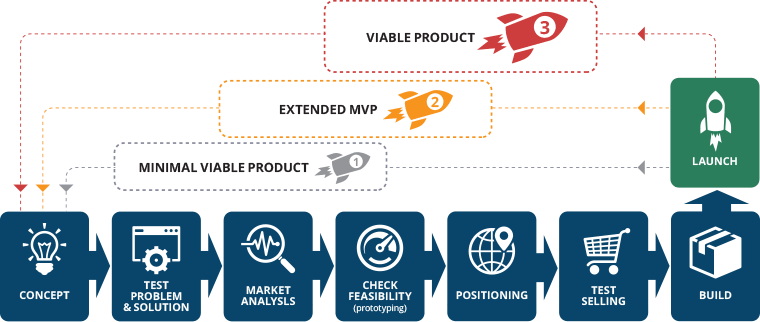Table of Contents
How companies can implement an agile approach to offshore software development and achieve significant improvements in the work with distributed teams
Due to the impact of COVID-19, spending on IT services in 2022 were amount to around 1.2 trillion U.S. dollars worldwide, which means 11.2 % growth compared to 2020. It also influenced the IT-outsourcing market revenue, expected to be approximately 413.7 billion U.S. dollars in 2022.
Today, many companies move their software development activities offshore to achieve cost savings, save time, and optimize their product development processes. Market’s high demand for experienced developers provided access to a broader tech talent pool through offshore outsourcing. In the previous post, we’ve already discussed why and where to hire a dedicated development team and how it can help to streamline your startup.
In a nutshell, hiring an offshore development team allows startups to build a high-quality MVP while saving their funds and time. It also lets the startup create new features, conduct experiments, and work on the backlog for short or long-term projects without worrying about human resources. However, as opposed to the management of traditional teams, managing offshore teams involves a set of specific challenges such as culture, communication, multiple locations and time zones, task management, discipline, control, and flexibility. Therefore, it requires an efficient methodology that would allow distributed teams to work effectively.
The effectiveness of the work of an offshore team depends mainly on implementing the proper offshore team management practices, which will coordinate all work processes. An agile methodology is a particular approach to project management that emphasizes collaboration, flexibility, continuous improvement, and high-quality results. It provides an efficient and flexible approach to software development and helps teams produce better software. offshore team management
So the question is: how can agile techniques be used in an offshore setting? Are Agile approaches applicable to offshore development teams, mainly if the teams are scattered around the world in different time zones and cultures?
What is Agile Software Development?
Agile methodology is already used worldwide as a convenient and practical framework for software development that helps teams deliver value to their customers faster. If you consider agile software development, you should decide on one of its frameworks to work with your team. It includes Scrum, Extreme Programming, or Feature-Driven Development (FDD). The Agile Manifesto published in 2001 contains four foundational values and 12 key principles of the Agile Methodology that guide the teams. One main benefit of this methodology is adapting and changing at any step depending on the market conditions and feedback.
The agile approach aims to help development teams uncover better ways of building software products by providing a clear framework that promotes iterative development and team collaboration, focusing on quality and efficiency. What differentiates Аgile from other approaches is the focus on collaboration and self-organizing cross-functional teams.
Challenges of offshore team management
Agile software development outsourcing can significantly benefit startups; however, at the same time, business owners should expect to face some challenges regarding development team management:
- Time differences and short time overlaps, cultural differences, language barriers, lack of face-to-face interactions, which are Agile fundamentals, may cause miscommunication between in-house and offshore teams.
- Sloppy onboarding. Managers tend to skip or fasten the onboarding process, especially when they hire experienced senior software developers, which leads to poor engagement and productivity.
- Cyber security. The recent switch to hybrid or remote work environments significantly reduced the issue of security during the work on development projects. However, it is still a must-have to provide software that prevents cyberattacks and data leaks when working with remote teams.
- Flexibility. It mainly concerns an in-house team who is used to one way of working and needs to adapt to other tools, adjust working times or schedules, spend more time on communication and documentation.
You may avoid most of those challenges if the processes are in place and you have detailed sprint planning. So, if you have an offshore development team, how do you successfully implement an Agile approach?
Get the most of an agile offshore development team
1. Define the product vision statement
Before starting work on the agile project with a distributed development team, it is necessary to determine the volume of all the tasks completed by a given date. This step helps build a comprehensive work strategy or the Scope of Work (SOW) and present a complete picture of the project to the team. The Scope of Work should contain the milestones, reports, and timeline for all deliverables expected to be provided by the team.
Based on the scope of work, the project divides into several parts and specific sets of tasks that you will use later for planning product iterations. That allows the product development to be more flexible and makes it easier to change the priority of tasks depending on the user feedback and other external factors.
2. Create a clear product roadmap

Once you create the list of the general tasks, you need to divide all the scope of work by time intervals to create a product development roadmap. The product roadmap is a high-level view of the requirements necessary to achieve the product vision. It is important to note that product roadmap is a flexible instrument, so deadlines and functionality may vary depending on the speed of the development process, user requirements, and other external factors. Its main goal is to create a clear picture of the product development process available for all offshore development team members.
To constantly see the progress and quickly make changes in the direction of the product roadmap, the development process divides into short iterations called sprints. The team creates a list of tasks with descriptions and time estimates for development work for sprint planning.
3. Conduct regular demos
The demo demonstrates the intermediate result of the teamwork that happens at the end of each iteration. The demo’s primary purpose is to show what the team managed to achieve during the sprint and understand whether the team performance meets the standard requirements. The product owner or the project manager should give the team constructive feedback and document it at demos. Also, it is crucial to analyze the last iteration, identify positive and negative points, and develop solutions for them.
Because all software development team members are actively involved in the demo, there is a continuous collaboration between all parties, especially for distributed teams.
4. Invest in collaboration technology
Collaboration technology helps offshore development teams be more effective. Such tools as Trello, Slack, and JIRA help the agile development team make the collaboration workflow easy and transparent. Despite the differences in locations and time zones, these tools don’t replace sitting in a room together, but they help keep the whole crew on the same page, making them essential for offshore team management.
5. Use agile team meetings to sync up team members
Daily standup, a quick 15-minute get-together, is a good instance for agile development teams who work between different time zones. The goal of daily standups is to share the plans for the day, set agendas, and discuss any problems. Such regular short meetings could be a simple yet effective way of ensuring the entire distributed agile team is in sync. You can use a daily standup tool to improve the management of your meetings.
6. Always communicate with customers to grow your product
One of your final goals for the product is to improve Customer Satisfaction Index and bring value to your users. To make that happen, run customer interviews during the development process, receive feedback about new features, and pass it to your development team.
When you work with distributed teams, it’s hard to communicate the product vision exactly as you see it, as there is always a risk of understanding the requirements and the outcome in the wrong way. User stories, feedbacks, recorded videos from user testing will make the target for programmers more clear. Additionally, consider what touchpoints your development team may have with Beta Testers (if you have them during the testing period), as it’s a good time to bring valuable changes and work on bugs before releasing the final product version to market.
Remember that your tech team is now from different parts of the world, and they are new to your company; that is why provide them as much information about your customers as possible.
Prioritize asynchronous communication
One of the fundamental pillars of the agile development team is the importance of communication between the people and teams involved in software development. But considering that the work of the distributed agile teams takes place mostly remotely, and team members are not sitting in one office, communication becomes significantly more complicated.
Asynchronous communication is oxygen for remote development teams. The timezone difference is one of the main problems that affect communication in the team in the first place.
According to Chris Brookis, The Chief Product Officer at Help Scout, for remote engineering teams, ‘nearly everything should be optimized for asynchronous communication — daily standups, code reviews, feature demos, project updates, and so on.’
When a team is scattered around the world in different time zones, most management problems are solved by building the proper communication. Some of the best practices for communication for the agile development team include:
- All team members must be available to communicate with each other to resolve issues on time.
- Communication should be transparent for all team members.
- All decisions made need to be communicated and documented.
- Building a single vocabulary to smooth the communication context will help to improve clarity and avoid misunderstandings.
- Conducting regular short status meetings for the entire team helps to improve collaboration and coordination.
- With time zone problems, it’s essential to keep the time for calls and video meetings as consistent as possible.
Add vetted software engineers to your team
Different communication tools work for different kinds of problems. Successful distributed agile teams use five main communication tools:
- Team chats and instant messaging tools such as Slack, where team members can discuss tasks and problems daily, arrange meetings, and more.
- Project management tools such as JIRA are used to plan all tasks and describe the work process. It is crucial to create one project environment where all tasks are stored centrally, and every team member has access to them.
- Wikis contain standard information, such as design guidelines, instructions, notes on progress, or anything else that your teams need for references.
- Email is often used to send reports or other official project documents and share decisions with all who need to be informed.
- Voice and video calls are required for lengthy discussions, for example, for strategic planning sessions.
Create a consistent development environment
It is crucial to have a designated product lead with the autonomy and the accountability to make decisions and take responsibility for the overall outcomes working with offshore teams. This person could be a CTO, a project manager, a Scrum master, or a product owner.
The following three simple steps represent the work required to achieve high performing offshore development teams:
- Build trust between teams in a distributed work environment.
Agile development teams thrive in an environment that promotes autonomy, trust, and flexibility. Project involvement plays a crucial role in the offshore team – if people do not feel their contribution to the overall project success, the team’s potential falls. Teams that receive requirements to “code up” have much less motivation and involvement. It is vital to make the offshore team feel like a partner, help team members understand the business context and create a sense of purpose to achieve a high level of engagement in the project.
- Minimize the friction in setting up the development environment
There is no standard development practice that allows effective collaboration across time zones and locations. The only way to find the best available set of processes and tools for the particular project and team.
Distributed teams rely more heavily on processes and tools. The project lead should provide the team with direction and guidance and ensure the team has the right tools to do their best work and focus on delivering value for the customers and the business.
- Create guidelines for effective work
Offshore development teams should have a common understanding of the best work practices and standards they will adopt and follow. The team lead keeps standards high and ensures all the expectations and instructions are clear to everyone on the team. Managing offshore development teams, it is always important to clearly define the goals, priorities, and milestones and document them.
Putting it together
In many cases, distributed development teams can be as productive or even more productive than co-located teams. Agile with offshore teams can be a key component in achieving this high level of effectiveness. Despite different geographic locations, there are many possibilities to utilize the best agile practices to achieve high performance and build trustful partnerships with offshore development teams.







